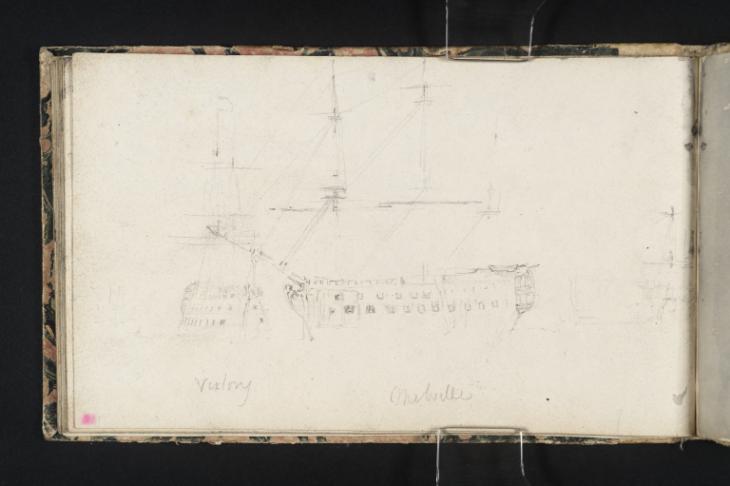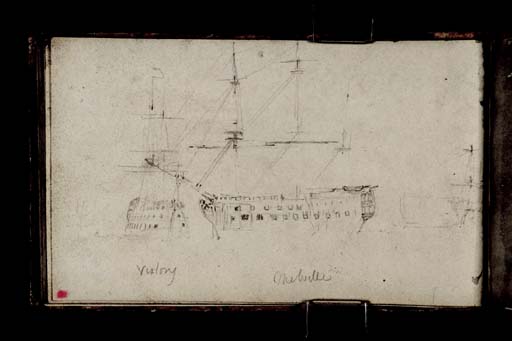Joseph Mallord William Turner HMS 'Victory' and HMS 'Melville' at Portsmouth c.1827
Image 1 of 2
Joseph Mallord William Turner,
HMS 'Victory' and HMS 'Melville' at Portsmouth
c.1827
Joseph Mallord William Turner 1775–1851
Folio 22 Verso:
HMS ‘Victory’ and HMS ‘Melville’ at Portsmouth c.1827
D20766
Turner Bequest CCXXVII 22
Turner Bequest CCXXVII 22
Pencil on white wove paper, 110 x 185 mm
Partial watermark ‘J & R A | 18’
Inscribed by Turner ‘Victory’ towards bottom left and ‘Melville’ bottom centre
Partial watermark ‘J & R A | 18’
Inscribed by Turner ‘Victory’ towards bottom left and ‘Melville’ bottom centre
Accepted by the nation as part of the Turner Bequest 1856
References
1827
A.J. Finberg, A Complete Inventory of the Drawings of the Turner Bequest, London 1909, vol.II, p.699, CCXXVII 22, as ‘The “Victory” and “Melville”’, c.1827.
Two fully-rigged warships are shown: HMS ‘Melville’ in elevation from the port side at the centre, with HMS ‘Victory’ almost head-on beyond to the left. The ‘Melville’ was a 74-gun third-rater, launched in 1817 and decommissioned in 1873 after service both in action and as a hospital ship in Hong Kong.1
The ‘Victory’ is perhaps the most famous ship in British naval history, having served as Lord Nelson’s flagship at Trafalgar in 1805. Turner first saw her and went aboard on her return late that year, as recorded particularly in the Nelson sketchbook (Tate; Turner Bequest LXXXIX); see David Blayney Brown’s introduction to the latter in the ‘Marine Subjects c.1803–14’ section of this catalogue. Two paintings had followed in 1806, The Battle of Trafalgar, as Seen from the Mizen Starboard Shrouds of the Victory (reworked 1808; Tate N00480)2 and The Victory Returning from Trafalgar (Yale Center for British Art, New Haven)3 and in 1823–4 Turner had produced The Battle of Trafalgar (National Maritime Museum, London)4 for George IV; his largest work, it had a mixed reception.
By contrast he records the ‘Victory’ inconspicuously here, almost as an afterthought to the ‘Melville’. She had been moored at Portsmouth as depot ship since 1812.5 Today she remains in dry dock at Portsmouth Historic Dockyard. In 1823 Turner had asked the marine artist John Christian Schetky (1788–1874) to make sketches of the former ‘in Hayle [sic, for Haslar?] Lake or Portsmouth Harbour’ in connection with the royal commission.6 There are later, unrelated drawings by Schetky in an album of his marine sketches (National Maritime Museum, London) showing the ‘Victory’ and ‘Melville’ at Portsmouth on 27 April and 27 August 1827 respectively. The latter date coincides with Turner’s time on the Isle of Wight addressed in the present section; see under folio 2 recto (D20735) for views of the island in the present sketchbook.
For various views of Portsmouth scattered through this sketchbook, see under folio 10 recto (D20768).
See Peter Davis, ‘William Loney RN – Background’, HMS Surprise, accessed 27 October 2015, http://www.pdavis.nl/ShowShip.php?id=1755 .
Technical notes:
As discussed in the sketchbook’s introduction, this leaf’s blank recto does not have a Tate ‘D’ accession number. It was prepared with a grey wash, and is inscribed by John Ruskin in red ink ‘22’ and stamped in black ‘CCXXVII – 22’ at the bottom right.
Matthew Imms
November 2015
How to cite
Matthew Imms, ‘HMS ‘Victory’ and HMS ‘Melville’ at Portsmouth c.1827 by Joseph Mallord William Turner’, catalogue entry, November 2015, in David Blayney Brown (ed.), J.M.W. Turner: Sketchbooks, Drawings and Watercolours, Tate Research Publication, November 2016, https://www


